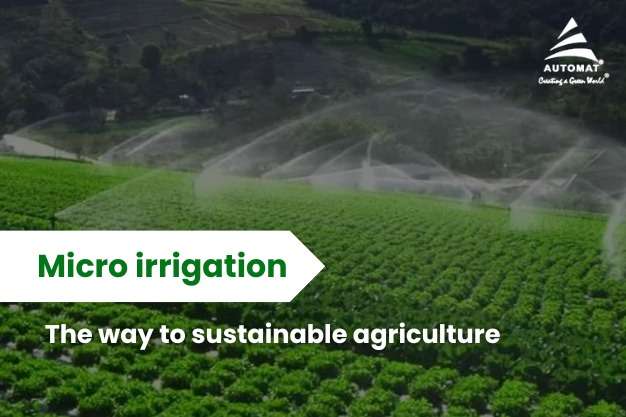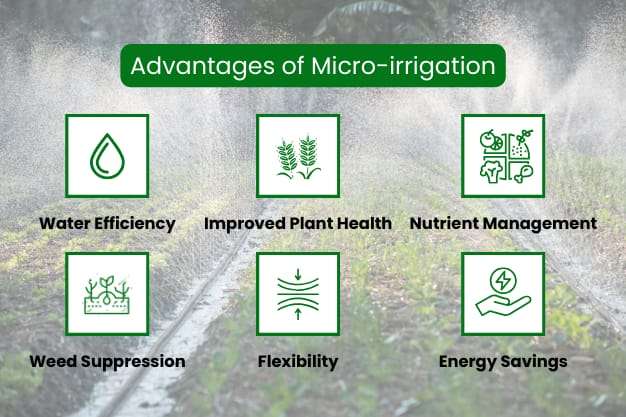
Introduction
India is majorly an agricultural country and has a huge requirement of water to produce commodities. Current and future agricultural needs can be met by increasing water consumption more efficiently in agriculture, enabled by the introduction of innovative measures and technologies such as micro-irrigation. We already have various micro-irrigation systems in use, however, the economics of these systems is a barrier for adoption by small landholder farmers in developing countries like India. The growing population of India will increase the demand for food, which can be fulfilled by the adaptation of micro-irrigation to improve agricultural production through efficient water use. Micro-irrigation is a key Innovative technology for efficient water use and enhanced agricultural output.
Read more: How to increase your yield of the crop using sprinklers?
What is Micro-irrigation
For decades India predominately used flood irrigation, which was extremely wasteful and inefficient form of irrigation. Micro-irrigation, also known as drip irrigation or trickle irrigation, is a method of irrigation that delivers small amounts of water directly to plant roots. This is a highly efficient irrigation technique that minimizes water waste and maximizes water utilization efficiency.
In a micro-irrigation system, water is distributed through a network of pipes or tubes with emitters such as drip emitters and micro-sprinklers placed near the plants. These emitters release water slowly and locally, directing water to the root area of each plant. This targeted approach ensures water is applied only where it is needed, reducing evaporation and wasteful runoff.
There are two main types of micro-irrigation systems.
Smart irrigation systems help reduce water and electricity bills by optimizing water usage. Water is a precious resource, so minimizing waste means lower costs for homeowners, businesses and farms. In countries with higher peak hour tariffs, smart irrigation systems can be programmed to take benefit of the low tariff periods ensuring substantial cost benefits to the user.
Read more: Importance of Filtration for Increasing the Life of an Irrigation System
Drip Irrigation
In drip irrigation, small emitters or drippers are placed along the irrigation line. These emitters release water drop by drop, providing a slow and steady supply of water to your plants. Drip irrigation is widely used for row crops (give examples), orchards, vineyards and garden beds.
Micro-sprinkler irrigation
Micro-sprinkler irrigation uses low-volume sprinklers or mini-sprinklers that atomize water into a fine mist or spray pattern. These sprinklers can cover a larger area compared to drop emitters and are widely used in Greenhouse nurseries, landscaping and gardens.
Micro-irrigation has several advantages over other irrigation methods.

Water Efficiency
Micro-irrigation delivers water directly to the root zone, or to the plant, minimizing evaporation and runoff to reduce water waste.
Improved plant health
Micro-irrigation provides water directly to the root zone of plants, ensuring more efficient water intake, resulting in healthier plants with less risk of disease and pests. is obtained.
Nutrient management
Micro-irrigation systems can integrate fertilizers and other water-soluble nutrients, allowing for precise and controlled application and improving nutrient uptake by plants.
Weed Suppression
Water is supplied directly to the plants, keeping the area between the plants dry and suppressing weed growth.
Flexibility
The micro-irrigation system can be easily adapted to different crop types, soil conditions, and topography.
Energy savings
Micro-irrigation systems require less pressure and flow than traditional sprinkler systems, resulting in energy savings as lower capacity pumps and systems are required, thus saving on electricity bills.
Overall, micro-irrigation is an efficient and sustainable irrigation method that saves water, increases crop productivity, and promotes environmental protection.
With an emphasis on irrigation in India, micro irrigation technology can be used to enhance the utilisation of our limited water resources.
The following are higher benefits of the micro irrigation technology:
-
-
- The efficiency of irrigation increased by 50% to 90%.
- 28.5% more fertilizer can be used per unit of area.
- Up to 30.5% less energy usage.
-
Micro-irrigation acts as an enabling technology for sustainable agriculture because it addresses many issues of agricultural growth and governments can play an important role in introducing this newer technology to farmers. Higher usage of newer sustainable technologies like micro-irrigation, can be encouraged by providing information to the farmers and have an effective subsidy scheme to lower the cost of adaptation.




